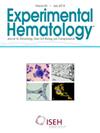Mtg16 NHR1 mutations cause defects in lymphopoiesis and the response to anemia
IF 2.1
4区 医学
Q2 HEMATOLOGY
引用次数: 0
Abstract
The Eight-Twenty-One (ETO)/Myeloid Translocation Gene (MTG) family of transcriptional corepressors play a key role in adult stem cell function across multiple tissues and may be affected by mutation, deletion, or translocation in solid tumors and leukemia. Structural studies of the first conserved domain identified residues that make specific contacts with E proteins, such as HEB and E2A. We generated mice with a mutation in a critical phenylalanine (F210A) in Mtg16 to test the physiological significance of Mtg16 association with E proteins and compared these mice to mice containing a nearby cancer-associated mutation (P209T). We found that Mtg16−/− and Mtg16F210A/F210A mice showed impaired lymphopoiesis following competitive bone marrow transplant, suggesting that the repression of E protein-dependent transcription is critical for B- and T-cell development. Although Mtg16−/−, Mtg16P209T/P209T, and Mtg16F210A/F210A animals showed significant defects in burst forming potential (BFU-E) after phenylhydrazine treatment, only Mtg16−/− mice showed overt signs of anemia. Thus, we propose that, although Mtg16 is a critical regulator of hematopoietic stem and progenitor cell (HSPC) function, response to hemolytic anemia, and lymphoid development, the interaction between Mtg16 and E proteins is particularly important for lymphopoiesis.
Mtg16 NHR1突变导致淋巴系统缺陷和对贫血的反应。
转录共抑制因子ETO/MTG家族在多种组织的成体干细胞功能中发挥关键作用,并可能在实体瘤和白血病中受到突变、缺失或易位的影响。第一个保守结构域的结构研究确定了与E蛋白(如HEB和E2A)有特定接触的残基。我们产生了Mtg16中关键苯丙氨酸(F210A)突变的小鼠,以测试Mtg16与E蛋白关联的生理意义,并将这些小鼠与附近含有癌症相关突变(P209T)的小鼠进行比较。我们发现Mtg16-/-和Mtg16F210A/F210A小鼠在竞争性骨髓移植后表现出淋巴功能受损,这表明E蛋白依赖性转录的抑制对B细胞和t细胞的发育至关重要。Mtg16-/-、Mtg16P209T/P209T和Mtg16F210A/F210A动物在苯肼处理后爆发形成电位(BFU-E)出现明显缺陷,只有Mtg16-/-小鼠表现出明显的贫血迹象。因此,我们提出,虽然Mtg16是HSPC功能、溶血性贫血反应和淋巴细胞发育的关键调节因子,但Mtg16和e蛋白之间的相互作用对淋巴生成尤为重要。
本文章由计算机程序翻译,如有差异,请以英文原文为准。
求助全文
约1分钟内获得全文
求助全文
来源期刊

Experimental hematology
医学-血液学
CiteScore
5.30
自引率
0.00%
发文量
84
审稿时长
58 days
期刊介绍:
Experimental Hematology publishes new findings, methodologies, reviews and perspectives in all areas of hematology and immune cell formation on a monthly basis that may include Special Issues on particular topics of current interest. The overall goal is to report new insights into how normal blood cells are produced, how their production is normally regulated, mechanisms that contribute to hematological diseases and new approaches to their treatment. Specific topics may include relevant developmental and aging processes, stem cell biology, analyses of intrinsic and extrinsic regulatory mechanisms, in vitro behavior of primary cells, clonal tracking, molecular and omics analyses, metabolism, epigenetics, bioengineering approaches, studies in model organisms, novel clinical observations, transplantation biology and new therapeutic avenues.
 求助内容:
求助内容: 应助结果提醒方式:
应助结果提醒方式:


